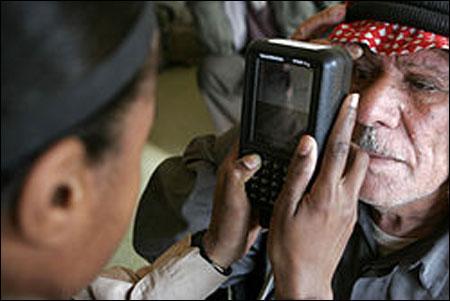 | « Back to article | Print this article |
Iris scan to add layer to Aadhaar authentication
One of the biggest purported flaws of the Unique Identification Authority of India (UIDAI)'s Aadhaar programme was the risk of deterioration of beneficiaries' fingerprint quality, especially given the country's large farm worker population, among the main target groups.
But, almost in sync with the government's plan of rolling out the ambitious direct benefits transfer (DBT) scheme nationwide, starting with 20 districts from January 1, the UIDAI is finishing work on introducing iris-based authentication in the first quarter of 2013, said a senior UIDAI official.
The iris, a circular structure in the eye, is responsible for controlling the diameter and size of the pupils. The colours, textures and patterns of each individual's irises are thought to be unique.
This type of authentication would allow UIDAI to not only use iris scans of residents taken during Aadhaar enrolment for de-duplication (eliminating duplicates), it could also utilise these, along with fingerprint scans, to reduce the overall rate of authentication failures.
"There are some huge advantages with iris," the official said. "(For example) a labourer's fingerprints may get worn out, but his iris won't. Iris patterns are much more solid and give a lot more information."
Although the UIDAI came for criticism in 2011, particularly from the home ministry, for the cost of scanning the irises of every resident who enrolled for Aadhaar, the official explained this was a requirement because it would be difficult to ensure accuracy in de-duplication in excess of 99 per cent on the basis of just one biometric measure.
"One fingerprint will give me limited information. Five fingerprints will mean more information and less chances of error. Similarly, if I have the iris (data) also, there is a wider set of information about a person and, therefore, the points of distinctness become much larger. And, the probability that both the iris and the finger will match is exceedingly small," the official said.
Despite its utility, iris-based authentication was previously unfeasible, primarily due to the cost of scanners. "But now, we have seen very low-cost devices, some as low as those used for fingerprint authentication," the official said, adding a clutch of both domestic and international vendors, including Koreans, were being roped in for a proof of concept (PoC), subsequent to which vendors would be empanelled.
"There are no standards in iris authentication available, as of now," the official said. "We will be the first ones in the world who will have iris image and transmission standards, matching algorithms and compression (standards) well-defined."
However, in a PoC conducted last year in Karnataka's Mysore district, the failed authentication rate stood at only 0.79 per cent for single-eye cameras and 0.60 per cent for dual-eye cameras, for about 5,000 residents. "The results clearly demonstrate iris authentication to be viable in the Indian context," the PoC report said.
But the real test for the technology would come if and when it is implemented nationwide from early this year, as DBT expands in its reach and scope.

